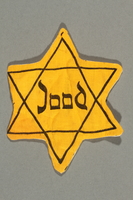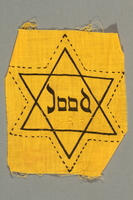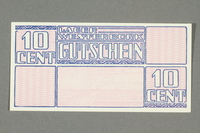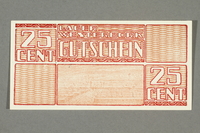Overview
- Description
- Contains a testimony of Helmut Rosendahl (donors' father) and a speech he gave in Germany, along with a copy of the English translation of the speech, regarding his experiences during the Holocaust.
- Credit Line
- United States Holocaust Memorial Museum Collection, Gift of Lea Rosendahl and Emmy Rosendahl Reid, daughters of Helmut Rosendahl.
Physical Details
- Genre/Form
- Personal narratives. Speeches.
- Extent
-
1 folder
Rights & Restrictions
- Conditions on Access
- There are no known restrictions on access to this material.
- Conditions on Use
- The donor, source institution, or a third party has asserted copyright over some or all of these material(s). The Museum does not own the copyright for the material and does not have authority to authorize use. For permission, please contact the rights holder(s).
- Copyright Holder
- Lea Rosendahl
Administrative Notes
- Holder of Originals
-
United States Holocaust Memorial Museum
- Legal Status
- Permanent Collection
- Provenance
- Donated to the United States Holocaust Memorial Museum in 2018 by Lea Rosendahl and Emmy Rosendahl Reid, daughters of Helmut Rosendahl.
- Record last modified:
- 2024-03-08 07:33:34
- This page:
- https://collections.ushmm.org/search/catalog/irn616231
Download & Licensing
- In Copyright
- Terms of Use
- This record is not digitized and cannot be downloaded online.
In-Person Research
- Request 7 Days in Advance of Visit
- Plan a Research Visit
-
Request in Shapell Center Reading Room
Bowie, MD
Contact Us
Also in Helmut Rosendahl collection
The collection consists of two Star of David Badges, Westerbork scrip, testimony, and a speech relating to the experiences of Helmut Rosendahl during and after the Holocaust in the Netherlands and Germany.
Date: 1941-1995

Factory-printed Star of David badge worn by a Jewish person in the Netherlands
Object
Factory-printed Star of David badge, owned by a Jewish person in the Netherlands. Germany invaded the Netherlands in May 1940. On April 29, 1942, all Jews in the Netherlands were required to wear a badge, which consisted of a yellow Star of David with a black outline and the word “Jew” printed inside the star in Dutch. The badge was used to stigmatize and control the Jewish population. Prior to this large-scale decree, identification requirements for Jewish individuals varied by locality and administration. Duplicated from those printed in Germany, these badges were made by factories such as De Nijverheid, a formerly Jewish-owned firm in the Netherlands that printed a large amount of Dutch stars.

Uncut factory-printed Star of David badge acquired by a Jewish person in the Netherlands
Object
Factory-printed Star of David badge, owned by a Jewish person in the Netherlands. Germany invaded the Netherlands in May 1940. On April 29, 1942, all Jews in the Netherlands were required to wear a badge, which consisted of a yellow Star of David with a black outline and the word “Jew” printed inside the star in Dutch. The badge was used to stigmatize and control the Jewish population. Prior to this large-scale decree, identification requirements for Jewish individuals varied by locality and administration. Duplicated from those printed in Germany, these badges were made by factories such as De Nijverheid, a formerly Jewish-owned firm in the Netherlands that printed a large amount of Dutch stars.

Westerbork transit camp voucher, 10 cent note, acquired by a former inmate
Object
Voucher, valued at 10 cents, distributed in Westerbork transit camp, and acquired by Helmut Rosendahl, a German Jewish man held there in 1944. While at the camp, inmates were compelled to work, and a special currency was issued to incentivize output, but the money had no real monetary value outside the camp. After Germany invaded the Netherlands on May 10, 1940, the German authorities began using Westerbork as a transit camp, holding internees until they were deported to forced labor camps or killing centers in other countries. The special currency was first distributed in 1944, and designed by Werner Löwenhardt, a Jewish artist who was imprisoned by the Germans in Westerbork from October 1942 until the camp was liberated in April 1945. The front design features a large chimney from the camp laundry and a street known as the Boulevard of Misery. The back design also features the chimney, in addition to a large, toothed spur gear. Both images support an illusion of an industrious camp as well as the hopelessness of inevitable deportation. Helmut was interned in Westerbork on September 2, 1942. His brother, father, and sisters were also held in Westerbork and several other camps. Helmut was deported to Theresienstadt ghetto-labor camp on September 4, 1944. He was deported again to Auschwitz-Birkenau killing center and Gleiwitz I as a forced laborer. In January 1945, Helmut was sent on a death march to Blechhammer, where he was liberated by the Soviet army. After Germany surrendered to the Allies in May 1945, Helmut was able to return to Amsterdam, where he reunited with his father.

Westerbork transit camp voucher, 25 cent note, acquired by a former inmate
Object
Voucher, valued at 25 cents, distributed in Westerbork transit camp, and acquired by Helmut Rosendahl, a German Jewish man held there in 1944. While at the camp, inmates were compelled to work, and a special currency was issued to incentivize output, but the money had no real monetary value outside the camp. After Germany invaded the Netherlands on May 10, 1940, the German authorities began using Westerbork as a transit camp, holding internees until they were deported to forced labor camps or killing centers in other countries. The special currency was first distributed in 1944, and designed by Werner Löwenhardt, a Jewish artist who was imprisoned by the Germans in Westerbork from October 1942 until the camp was liberated in April 1945. The front design features a large chimney from the camp laundry and a street known as the Boulevard of Misery. The back design also features the chimney, in addition to a large, toothed spur gear. Both images support an illusion of an industrious camp as well as the hopelessness of inevitable deportation. Helmut was interned in Westerbork on September 2, 1942. His brother, father, and sisters were also held in Westerbork and several other camps. Helmut was deported to Theresienstadt ghetto-labor camp on September 4, 1944. He was deported again to Auschwitz-Birkenau killing center and Gleiwitz I as a forced laborer. In January 1945, Helmut was sent on a death march to Blechhammer, where he was liberated by the Soviet army. After Germany surrendered to the Allies in May 1945, Helmut was able to return to Amsterdam, where he reunited with his father.



